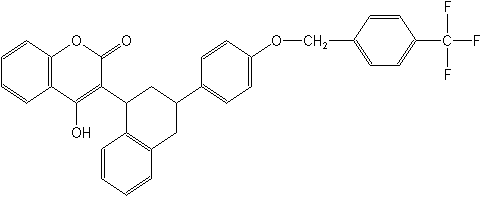|
Return to
Adverse Effects
Abstracts
ACTIVITY:
Rodenticide (coumarin)
CAS Name:
4-hydroxy-3-[1,2,3,4-tetrahydro-3-[4-[[4-(trifluoromethyl)phenyl]methoxy]phenyl]-1-naphthalenyl]-2H-1-benzopyran-2-one
Structure:

Adverse
Effects:
Ataxia
Embryotoxic
Liver
Teratogen
|
| Environmental
Effects:
Highly toxic to fish
High
toxicity to non-target animals and pose a significant secondary
hazard threat |
Regulatory
Information
(only comprehensive for the US) |
| US
EPA Registered: |
No |
Registered
use in
(includes only a limited list of countries)
|
Australia,
Denmark, Finland, Germany, India, New Zealand, Philippines,
Portugal, Singapore, Tanzania, UK |
| Other
Information |
| Molecular
Formula: |
C33H25
F3 O4 |
| Entry
Year: |
1989 |
| Inventing
Company: |
Sorex
Limited under contract to Shell International Chemical Company
Limited |
| Manufacturers: |
Cyanamid |
| Other
Names: |
Storm
Shell
WL 108366 |
| Manufacture
site: |
UK:
Shell Research Ltd., Sittingbourne, Kent
FRANCE:
Lipha Chimie Fine, Division Orchimie,
Lyon |
| Of
special interest: |
| PAN
BAD ACTOR (Acute Toxicity) |
| •
new - Flocoumafen:
Material Safety Data Sheets & Labels |
|
Evaluation
on Flocoumafen. April 1987.
UK Department for Environment,
Food and Rural Affairs, Pesticides Safety Directorate, Mallard
House, Kings Pool 3 Peasholme Green, York YO1 7PX. Also available
at http://www.pesticides.gov.uk/citizen/evaluations/evallist.htm
|
| 2000
- 2002 - Extremely hazardous. WHO
Recommended Classification of Pesticides by Hazard and Guidelines
to Classification 2000-2002. Table
1. EXTREMELY HAZARDOUS (Class Ia) active ingredients (technical
grade) of pesticides, p 16. |
| June
2002 - In Australia when Flocoumafen is used "In
baits as a rodenticide in situations where contact with crops,
food products, or soil in which crops are grown will not occur"
no maximum residue levels are required. Ref:
June 2002. Table 5. Uses of substances where maximum
residue limits are not necessary. Australian National Registration
Authority for Agricultural Veterinary Chemicals. The MRL Standard.
Maximum residue limits in food and animal feedstuff. http://www.nra.gov.au/residues/mrl5.pdf
|
| Abstracts |
| 1999
- Treatment
of Plague by Drs. Poland and Dennis. World Health Organization |
| 1995
-
Anticoagulant Rodenticides. International
Programme on Chemical Safety. Environmental Health Criteria
175. World Health Organization. |
Flocoumafen
was developed by Sorex Limited under contract to Shell International
Chemical Company Limited and it is also known by the code
Shell WL 108366 and the Shell Trade Mark 'Storm'... The
technical material is to be manufactured for Shell by Ward
Blenkinsop and Company Limited. A technical specification
is expected to be such that the technical material will
contain >90% w/w of active ingredient.
Flocoumafen
is a rodenticide for control of rats and mice. The product
would be sold to local authorities, firms and professional
operators providing a service of pest control and to persons
occupying industrial or commercial premises (ie food processing
factories, warehouses, etc, which carry out their own pest
control), but NOT farmers, gamekeepers or amateur
users. [Tests by the UK MAFF were carried out in the Welshpool
area, Hampshire, West Sussex, and at Kent farms.]
Ref:
Evaluation
on Flocoumafen. April 1987. UK
Department for Environment, Food and Rural Affairs, Pesticides
Safety Directorate, Mallard House, Kings Pool 3 Peasholme
Green, York YO1 7PX.
Also available at http://www.pesticides.gov.uk/citizen/evaluations/evallist.htm
|
In
the mid to late 1970s, a group of compounds known as the
"second generation" anticoagulants were developed.
These compounds include bromadiolone, difenacoum, brodifacoum,
flocoumafen and difethialone,
and are considerably more toxic, killing rodents that are
resistant to the first generation anticoagulants. With these
compounds rodents may eat enough to kill them in a single
day or in some cases in a single feeding, but they still
will take several days to die. While very successful and
widely used, these compounds and particularly the latter
three have quite a high toxicity to
non-target animals and pose a significant secondary hazard
threat. In a sense, they lack some of the advantages
of the first-generation anticoagulants. Some resistance
has also been documented to second-generation anticoagulants
in a few areas.
Ref: Advances in IPM Rodent
Control in Agriculture. CISSE W. SPRAGINS, Rockwell Laboratories
Ltd., Minneapolis, MN, USA. http://www.sustdev.org/journals/edition.01/download/01.135.pdf
|
|